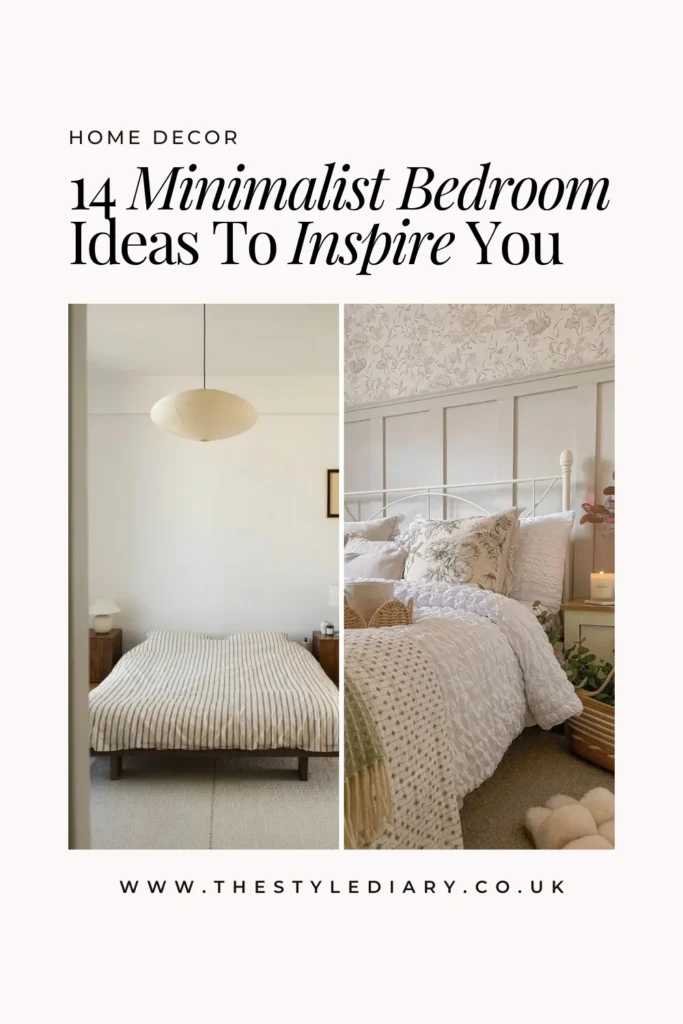Heads up! We may use affiliate links in this post. You'll never pay more, but we might earn a small commission if you buy - thanks for supporting us! See our full disclosure here.
Creating a space that lets you truly exhale at the end of a busy day isn’t just about aesthetics – it’s about intentional design.
These minimalist bedroom ideas prove that less really can transform your space into more, bringing that sense of serenity we’re all craving in our fast-paced world.
Whether you’re drawn to the cosy warmth of hygge, the zen-like balance of Japandi design, or simply want to create a calm bedroom that feels like a sanctuary, embracing minimalism might be exactly what your space needs.
Think clean lines, thoughtful details, and a carefully curated blend of form and function.
Sounds good? Great! We’ve gathered 14 inspiring ways to bring minimalist magic into your space, proving that simplified doesn’t mean stark, and less can feel luxuriously full. From subtle texture plays to strategic storage solutions, these ideas will help you create that peaceful retreat you’ve been dreaming of.
What Is Minimalist Interior Design?
Minimalist interior design was conceptualised by The Bauhaus, a revolutionary design school established by architect Walter Gropius in Germany in the 1920s.
Their philosophy of “form follows function” challenged ornate traditional designs, stripping away unnecessary decoration in favour of clean lines and purposeful elements.
The movement gained momentum in the 1960s when architects like Ludwig Mies van der Rohe famously declared “less is more” – a phrase that would become the cornerstone of minimalist design philosophy.
This deliberate shift toward simplicity wasn’t just about aesthetics; it represented a broader cultural movement toward intentional living.
Key Elements of Minimalist Design:
- Intentional furniture placement
- Careful curation of décor
- Focus on natural light
- Quality over quantity
- Neutral colour palettes with subtle texture
- Hidden storage solutions
- Clean, architectural lines
Today’s interpretation maintains these foundational principles while embracing a softer, more livable approach that prioritises both beauty and practicality.
So, if you want this look in your bedroom, here are 14 minimalist bedroom ideas that will inspire you.
1. Neutral Palette
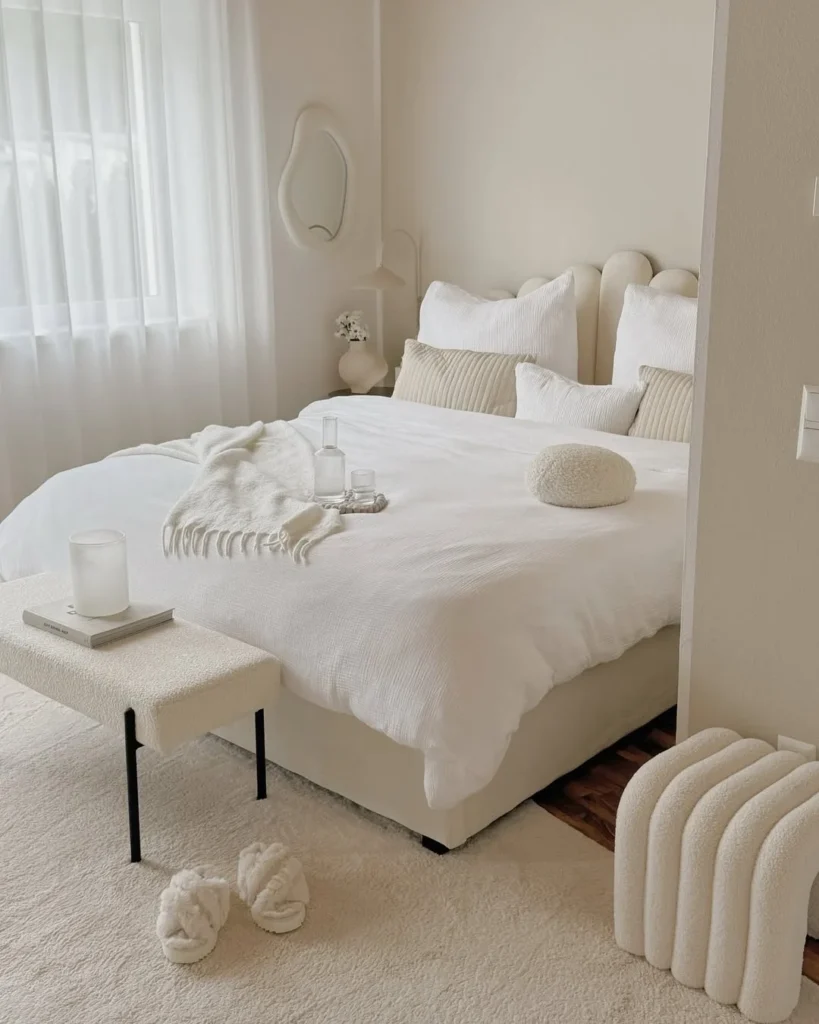
There’s an art to choosing neutrals that feel alive rather than flat. Think sophisticated layers of putty, warm cream, and whispered greys – shades that create a canvas for calm without falling into monotony.
These gentle hues do more than just look beautiful; they’re actually backed by colour psychology to promote tranquillity and rest.
The magic happens in the layering.
When you blend these quiet tones through different textures – perhaps a nubby bouclé throw against crisp linen sheets or a plush wool rug beneath a matte chalk-white wall – you create depth without disruption.
Tip: Look for neutrals with subtle undertones that shift beautifully as natural light moves through your space throughout the day. This creates an organic, evolving atmosphere that keeps your room feeling fresh rather than static.
2. The Power of One
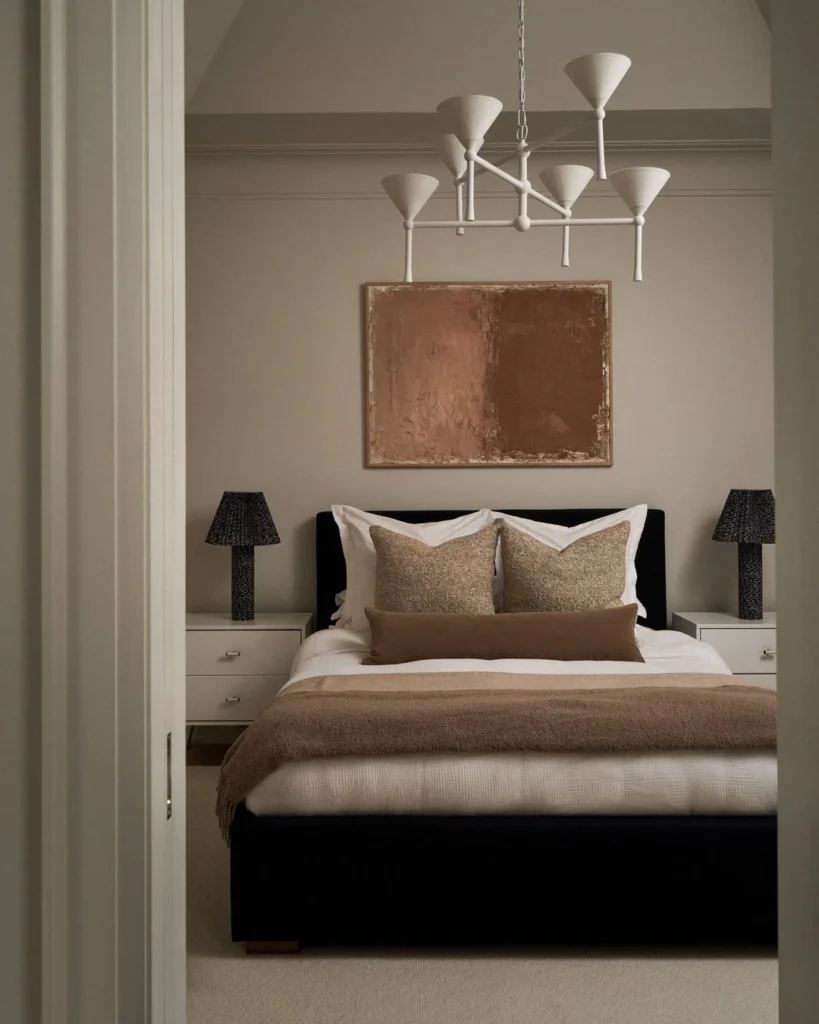
Think of your space like a perfectly composed photograph – sometimes a single striking element tells a more powerful story than multiple competing details. In minimalist design, choosing one hero piece becomes an exercise in confident restraint.
Perhaps it’s an oversized piece of abstract art that captures the morning light, a sculptural pendant that doubles as functional art, or a beautifully crafted vintage chair that serves as both a focal point and conversation starter.
This singular focus doesn’t just maintain visual calm – it transforms your space into something that feels more curated than decorated.
3. Sleek Storage Options
In the world of minimalist design, clever storage isn’t just practical – it’s an art form. It’s where every item knows exactly where to retreat when it’s not in use.
Built-in wardrobes that melt into walls, floating nightstands with secret compartments, and under-bed storage in natural materials become your allies in maintaining serenity.
The key is choosing solutions that feel intentional rather than afterthoughts. A well-designed storage system should work like a sophisticated magic trick – you know there’s organisation happening, but all you see is the beautiful end result.
This approach transforms your bedroom from a space that fights clutter to one that naturally encourages calm.
4. Simple Bedding
Think of your bed as a blank canvas where quality speaks louder than quantity. This isn’t about stripping away comfort, but rather about cultivating it through thoughtfully chosen layers.
Start with impeccable basics – perhaps cloud-soft Belgian linen sheets in barely-there shades, or hotel-grade Egyptian cotton that gets better with every wash. The goal is to create that coveted ‘perfect hotel bed’ feeling but with a more personal, lived-in sophistication.
The secret lies in selecting bedding that feels as good as it looks. Layer two or three complementary neutral tones rather than matching sets, and focus on subtle variations in texture rather than patterns.
A crisp fitted sheet, a soft flat sheet, and perhaps a single luxurious throw or quilt are often all you need. It’s about creating an inviting retreat that looks effortlessly put together, while being wonderfully comfortable to sink into at day’s end.
5. Accent With Black

In a minimalist bedroom, accents of black work like sophisticated punctuation marks, drawing the eye exactly where you want it to go.
A matte black reading lamp, slim-framed artwork, or sleek bed frame can transform a purely neutral space from simple to striking.
The key is using black strategically, like a designer’s secret weapon. Too much can feel heavy, but the right amount adds architectural interest and grounds your lighter elements.
Consider a black-framed mirror that seems to float on a white wall, or slate-coloured linen pillowcases that create subtle contrast against cream bedding.
Tip: Mix your blacks to create subtle interest – perhaps combine matte and glossy finishes, or pair smooth metal with textured fabrics.
6. Texture Instead Of Wall Art

Textured walls are like artwork that doesn’t need a frame – a subtle yet sophisticated way to bring dimension to your space without adding visual clutter.
Whether it’s a hand-troweled lime wash that catches light like morning mist, a textural grasscloth wallpaper, or a carefully applied Venetian plaster that mimics worn stone, these surfaces create interest through touch rather than colour.
The beauty of this approach lies in its subtlety. As natural light moves across these tactile surfaces throughout the day, it creates an ever-changing display of shadows and highlights – like having a living artwork that shifts with the hours.
It’s particularly powerful in a minimalist space, where the absence of traditional decor allows these nuanced textures to become the quiet star of your room.
Tip: Consider layering different textures at different scales – perhaps a micro-textured wall against larger-scale textural elements like a fluted wood panel or a ribbed ceiling detail.
7. Incorporate Scandinavian Minimalism
Think of Scandinavian minimalism as the perfect balance between cosy and clean – it’s where hygge meets purpose, creating spaces that feel both sculpted and lived-in.
Unlike stricter minimalist approaches, this Nordic-inspired style embraces the gentle warmth of natural materials alongside its clean lines.
Picture pale wooden floors that catch morning light, curved furniture that invites you to linger, and textiles that feel like a warm embrace against winter’s chill.
The magic lies in its thoughtful contradiction – it’s minimal yet welcoming, curated yet comfortable. Layer a chunky knit throw over a streamlined chair, pair smooth birch furniture with softly textured wool rugs, or add warmth through rounded ceramic vessels and handcrafted details.
8. Add Paper Lamps
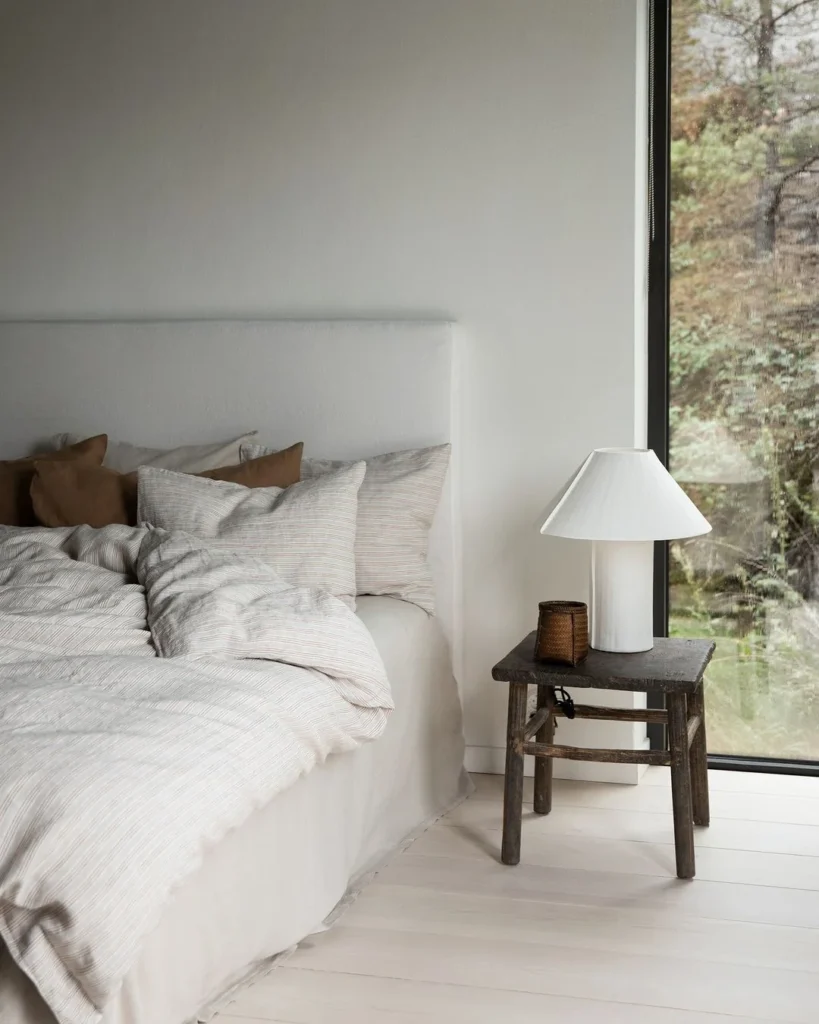
Think of paper lamps as floating clouds in your minimalist sanctuary – they add visual poetry without breaking your room’s serene rhythm.
Whether it’s a Noguchi-inspired sphere casting gentle shadows, or a cluster of rice paper pendants creating an ethereal glow, these lighting elements bring a weightless grace to your space. The magic lies in their ability to feel both modern and timeless, architectural yet organic.
The beauty of paper lighting goes beyond its gentle illumination. During daylight hours, these pieces become sculptural elements that add subtle texture and form.
Their translucent surfaces play with natural light, while their simple geometries complement your room’s clean lines. At night, they transform your space into a cocoon of soft, diffused light that feels both calming and considered.
Tip: Choose paper lamps in warm white rather than bright white to create that coveted golden-hour glow throughout your space.
9. Add Some Greenery

Think of plants as nature’s way of breathing life into minimalist design – they’re the perfect balance of form and function, adding organic shape and movement without disrupting your carefully curated calm.
A single oversized fiddle leaf fig can become a living sculpture, while a cascading pothos brings gentle movement to a quiet corner. These green additions do more than just look beautiful too; they actually improve air quality and help create a subtle connection to the natural world.
The secret is choosing plants that complement your minimalist aesthetic rather than compete with it. Consider the clean lines of a snake plant, the architectural beauty of a monstera, or the subtle drama of trailing eucalyptus in a simple ceramic vase.
Need some more plant ideas for your bedroom? Check out: 12 Best Plants For Your Bedroom
10. Consider Monochrome

Think of monochrome not as a limitation, but as a masterclass in subtle sophistication.
Like a black-and-white photograph that captures more detail than colour ever could, a single-tone approach forces you to notice the nuances – the interplay of light and shadow, the richness of varying textures, the power of subtle shifts in shade.
The key to mastering monochrome lies in understanding its depths. Perhaps you’ll choose warm whites that range from ivory to oatmeal, creating a cocooning effect that feels both grounding and ethereal.
Or maybe you’ll explore the world of greiges, where every surface tells a slightly different story of the same colour. It’s about building a space that feels cohesive rather than flat, sophisticated rather than stark.
11. Try Japandi
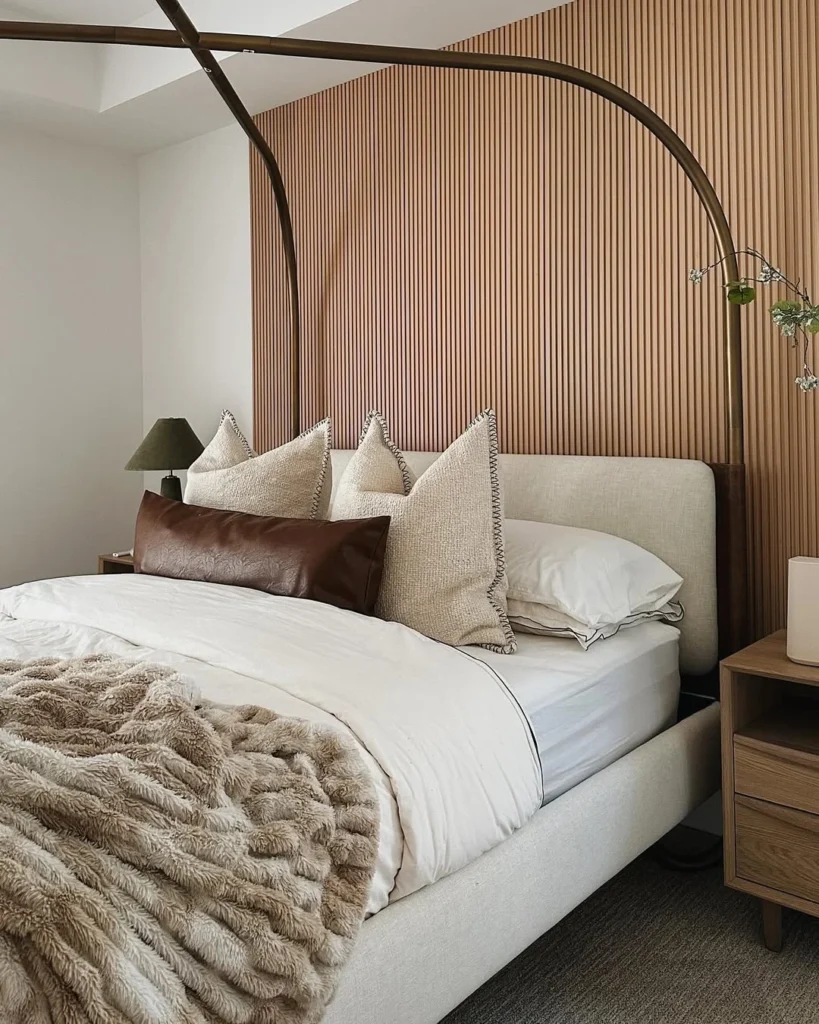
Think of Japandi as the design equivalent of a perfectly balanced meal – it combines Japanese minimalism’s thoughtful restraint with Scandinavian design’s cosy functionality.
Get the look by blending natural materials with clean lines – perhaps a low-profile platform bed in warm oak, paired with handcrafted ceramic accessories and simple linen bedding.
Add subtle touches of black as grounding elements, like matte black sconces or a sleek reading lamp, while keeping the overall palette warm and natural.
The result? A space that feels both contemporary and timeless.
The key is embracing ‘less but better’ – choosing quality pieces that celebrate natural imperfections and craftsmanship. Think hand-thrown pottery on a simple wooden shelf, or a carefully placed ikebana arrangement that brings the outside in.
RELATED: What Is Japandi Interior Design? | How To Effortlessly Achieve This Aesthetic At Home
12. Use Mid-Century Furniture
Mid-century furniture is like minimalism’s sophisticated predecessor – where clean lines and organic curves come together in perfect harmony.
These timeless pieces work beautifully in minimalist spaces precisely because their design philosophy already embodies the ‘form follows function’ principle that minimalists love.
A sculptural Eames chair or a sleek Danish dresser doesn’t just furnish your space – it elevates it with purposeful elegance.
The key is selecting pieces that let their silhouettes do the talking. Perhaps a low-slung walnut platform bed that seems to float above the floor, or a clean-lined nightstand with delicate peg legs that add visual lightness.
These classics work particularly well because they often incorporate hidden storage and multi-functional elements – perfect for maintaining that clutter-free environment we’re after.
13. The Power of Negative Space

Understanding negative space is like mastering the art of silence in a conversation – it’s just as important as what’s being said.
Those thoughtful gaps between furniture pieces and bare wall sections aren’t empty spaces waiting to be filled; they’re intentional design choices that create visual breathing room.
Think of it as giving your favourite pieces their moment to shine, like a perfectly curated gallery where each element has space to be appreciated.
Consider how morning light plays across an uncluttered wall, or how a simple vignette becomes more striking when given room to exist on its own.
This intentional use of space doesn’t just look sophisticated – it actually helps lower stress levels and promotes better sleep.
14. Textural Diversity
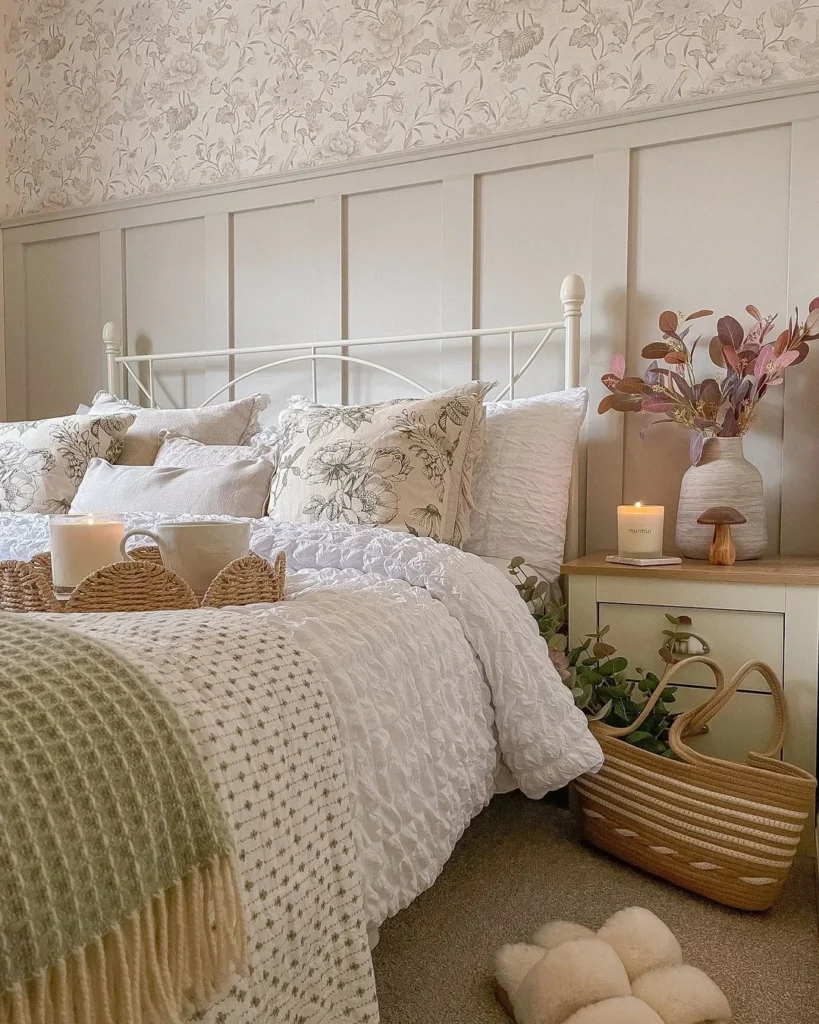
Creating interest without chaos is like composing a symphony using only a few carefully chosen instruments.
Layer a raw silk throw over luxuriously crisp sheets, juxtapose smooth bamboo surfaces against nubby linen upholstery, or anchor sleek furniture with a handwoven jute rug. Each texture adds its own note to the composition without disrupting the overall harmony.
This approach brings warmth and sophistication to your space while maintaining that essential minimalist calm. It’s about creating moments of discovery – surfaces that invite touch and create visual interest without ever overwhelming the senses.
Save on Pinterest for later?
